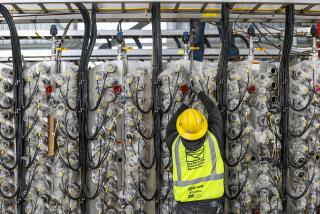18 More Wells Will Monitor Radiation in Water
- Share via
Rockwell International and U.S. Department of Energy officials said Friday that 18 additional ground-water monitoring wells will be installed by the end of the year in a portion of the Santa Susana Field Laboratory where nuclear research was conducted for nearly 40 years.
The announcement follows an Energy Department report that identified areas of radioactive and chemical pollution on the site and called for more environmental tests. The California Regional Water Quality Board in Los Angeles, responding to the report, said additional monitoring wells will be required at the site three miles west of Chatsworth and two miles southeast of Simi Valley.
The report said more wells are necessary since inadequacies in the lab’s ground-water monitoring system make it impossible to tell the full extent of chemical and radioactive pollution at the 2,668-acre complex. Currently, the company monitors 123 on-site wells.
James Werner, a former consultant who worked on the report, is a scientist with the Natural Resources Defense Council, an environmental group. He said news of the additional wells is “encouraging, but meaningless unless they work with the regulatory agencies” in placing the wells where they would be most likely to detect pollution.
Rockwell and Energy Department officials said Friday they intended to work with regulatory agencies in locating the new wells.
Officials said Friday in an interview that the additional wells “should put to rest any fears” about pollution moving off the site. Steve Lafflam, environmental manager of the site, said the 18 wells will cost the Energy Department about $250,000.
The lab, operated by Rockwell’s Rocketdyne division in a rugged area of the Simi Hills, has been on the state Superfund cleanup list for several years because of high levels of trichloroethylene, or TCE, a chemical solvent, in ground water beneath the complex. Rocketdyne has been treating ground water in one part of the property where TCE has been found at levels of up to 11,000 p.p.b., 2,200 times the amount that would be allowed in drinking water.
The report acknowledged apparently for the first time that some radioactive contamination also exists in soil and structures from nuclear operations and spills. Energy Department officials said radioactively contaminated soil exists in an area known as the sodium burn pit and a sewage leach field where radioactive water has been spilled. They said the highest radiation level found so far has been 4,900 picocuries per gram of soil, or up to 190 times the natural background levels.
Rocketdyne and Energy Department officials said pollution at the site poses no immediate threat to nearby residents.
Between 1947 and 1986, nuclear research was conducted on a 290-acre portion of the site, part of which was leased by Energy Department. About 12 nuclear reactors operated there, including the first plant in the United States to provide nuclear-powered electricity to consumers.
No nuclear work currently is being done at the site, although Rocketdyne plans to bid on contracts with Energy Department to recycle spent nuclear fuel rods, said R.J. Tuttle, manager of radiation and nuclear safety at the site.
Times staff writer Myron Levin contributed to this story.
More to Read
Sign up for Essential California
The most important California stories and recommendations in your inbox every morning.
You may occasionally receive promotional content from the Los Angeles Times.













